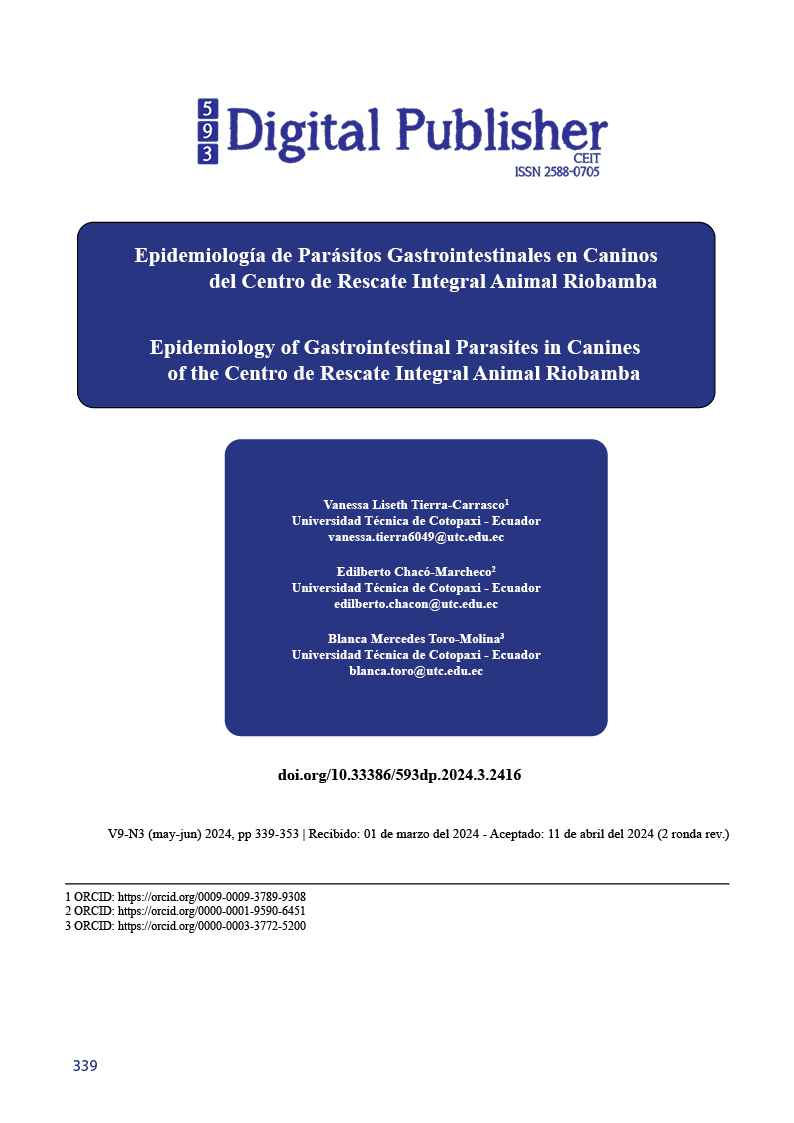Epidemiology of Gastrointestinal Parasites in Canines of the Centro de Rescate Integral Animal Riobamba
Main Article Content
Abstract
Dogs are humans' most cosmopolitan pets and, as such, a means of zoonotic transmission of parasites to their caregivers or owners. Therefore, the objective of the study was to evaluate the epistemology of gastrointestinal parasites in canines from the Centro de Rescate Integral Animal Riobamba (CRIAR). 40 clinically healthy dogs of both sexes were sampled. The fecal samples were subjected to two analysis techniques, saline flotation in saturated saline solution for the identification of specimens using and the modified McMaster technique for the quantification of oocysts/ova per gram of feces (HPG-OPG). Eight different species of gastrointestinal parasites were detected, being both Uncinaria stenocephala and Ancylostoma sp The most abundant, with a prevalence of 30% and 22.5%, respectively, also being present the species Cystoisospora canis (17.5%) and Toxocara canis (12.5%). In the case of Capillaria aerophila the prevalence was 7.5% and in Cryptosporidium parvum (5%). Less frequently, cases infected with Giardia lamblia and Echinococcus granulosus were identified with a prevalence of 2.5% in both cases. Concurrent infection with more than one species of gastrointestinal parasites was a common finding in dogs. The need to improve CRIAR's veterinary care is evident. In addition, defining the risk factors for transmission of zoonotic helminths to humans, and proposing public education programs on the proper care of dogs, personal hygiene by dog trainers and owners.
Downloads
Article Details

This work is licensed under a Creative Commons Attribution-NonCommercial-ShareAlike 4.0 International License.
1. Derechos de autor
Las obras que se publican en 593 Digital Publisher CEIT están sujetas a los siguientes términos:
1.1. 593 Digital Publisher CEIT, conserva los derechos patrimoniales (copyright) de las obras publicadas, favorece y permite la reutilización de las mismas bajo la licencia Licencia Creative Commons 4.0 de Reconocimiento-NoComercial-CompartirIgual 4.0, por lo cual se pueden copiar, usar, difundir, transmitir y exponer públicamente, siempre que:
1.1.a. Se cite la autoría y fuente original de su publicación (revista, editorial, URL).
1.1.b. No se usen para fines comerciales u onerosos.
1.1.c. Se mencione la existencia y especificaciones de esta licencia de uso.
References
Abere, T., Bogale, B., & Melaku, A. (2013). Gastrointestinal helminth parasites of pet and stray dogs as a potential risk for human health in Bahir Dar town, north-western Ethiopia. Veterinary World, 6(7), 388-392. https://doi.org/10.5455/vetworld.2013.388-392
Añaña, D. de C., Waller, S. B., Giordani, C., Perera, S. C., de Almeida Capella, G., Berne, N., Strothmann, A. L., Freitag, R. A., & Cleff, M. B. (2022). Ovicidal activity of the hydroalcoholic extract of Brazilian peppertree (Schinus terebinthifolia Raddi) against Ancylostoma spp. from naturally parasitized dogs. Natural Product Research, 36(22), 5899-5903. https://doi.org/https://doi.org/10.1080/14786419.2021.2023145
Aucancela, B. P., & Velasco, S. V. M. (2021). Gestión turística como herramienta de desarrollo sostenible de la microcuenca del Río Chimborazo, cantón Riobamba. Revista Chakiñan de Ciencias Sociales y Humanidades, 13(1), 102-116.
Calvopina, M., Cabezas-Moreno, M., Cisneros-Vásquez, E., Paredes-Betancourt, I., & Bastidas-Caldes, C. (2023). Diversity and prevalence of gastrointestinal helminths of free-roaming dogs on coastal beaches in Ecuador: Potential for zoonotic transmission. Veterinary Parasitology: Regional Studies and Reports, 40, 100859. https://doi.org/https://doi.org/10.1016/j.vprsr.2023.100859
Cerutti, R. D., Giannetto, C., Scaglione, M. C., Sciabarrasi, A., Fazio, F., & Piccione, G. (2021). Interspecies comparison of daily total locomotor activity between maned wolves (Chrysocyon brachyurus) and domestic dogs (Canis familiaris) maintained in captivity. Journal of Veterinary Behavior, 43, 24-27. https://doi.org/https://doi.org/10.1016/j.jveb.2021.01.002
Cheesbrough, M. (2005). District Laboratory Practice In Tropical Countries (C. U. Press (ed.)).
Del-Baldo, F., & Fracassi, F. (2023). Continuous Glucose Monitoring in Dogs and Cats: Application of New Technology to an Old Problem. Veterinary Clinics of North America: Small Animal Practice, 53(3), 591-613. https://doi.org/https://doi.org/10.1016/j.cvsm.2023.01.008
Ezema, K. U., Malgwi, S. A., Zango, M. K., Kyari, F., Tukur, S. M., Mohammed, A., & Kayeri, B. K. (2019). Gastrointestinal parasites of dogs (Canis familiaris) in Maiduguri, Borno State, Northeastern Nigeria: Risk factors and zoonotic implications for human health. Veterinary World, 12(7), 1150-1153. https://doi.org/10.14202/vetworld.2019.1150-1153
Gerardi, F., Santaniello, A., Del Prete, L., Maurelli, M. P., Menna, L. F., & Rinaldi, L. (2018). Parasitic infections in dogs involved in animal-assisted interventions. Italian Journal of Animal Science, 17(1), 269-272. https://doi.org/10.1080/1828051X.2017.1344937
Gómez, M. M., Lara, M. A., Alarcón, D. L., & Santos, D. C. (2021). Sustainability Strategies for Strengthening Agricultural Systems in Quimiag Parish, Riobamba Canton. ESPOCH Congresses The Ecuadorian Journal of STEAM, 1(15), 1400–1412. https://doi.org/10.18502/espoch.v1i5.9581
Guaman-Simba, D. D., Castillo-Hidalgo, E. P., & Armas-Ariza, J. C. (2022). Cambios electrolíticos en perros con gastroenteritis infecciosa. Revista Científica de la Facultad de Ciencias Veterinarias, XXXII(single), 1-4. https://doi.org/10.52973/rcfcv-e32136
Idika, I. K., Onuorah, E. C., Obi, C. F., Umeakuana, P. U., Nwosu, C. O., Onah, D. N., & Chiejina, S. N. (2017). Prevalence of gastrointestinal helminth infections of dog in Enugu State, South Eastern Nigeria. Parasite Epidemiology and Control, 2(3), 97-104. https://doi.org/10.1016/j.parepi.2017.05.004
Joachim, A., Auersperg, V., Drüe, J., Wiedermann, S., Hinney, B., & Spergser, J. (2023). Parasites and zoonotic bacteria in the feces of cats and dogs from animal shelters in Carinthia, Austria. Research in Veterinary Science, 164, 105022. https://doi.org/https://doi.org/10.1016/j.rvsc.2023.105022
Joao, L. M., Proença, L. R., Loiola, S. H. N., Inácio, S. V., dos Santos, B. M., Rosa, S. L., Soares, F. A., Stefano, V. C., Osaku, D., Suzuki, C. T. N., Bresciani, K. D. S., Gomes, J. F., & Falcão, A. X. (2023). Toward automating the diagnosis of gastrointestinal parasites in cats and dogs. Computers in Biology and Medicine, 163, 107203. https://doi.org/https://doi.org/10.1016/j.compbiomed.2023.107203
Kamani, J., Massetti, L., Olubade, T., Balami, J. A., Samdi, K. M., Traub, R. J., Colella, V., & González-Miguel, J. (2021). Canine gastrointestinal parasites as a potential source of zoonotic infections in Nigeria: A nationwide survey. Preventive Veterinary Medicine, 192, 105385. https://doi.org/https://doi.org/10.1016/j.prevetmed.2021.105385
Leutenegger, C. M., Evason, M. D., Willcox, J. L., Rochani, H., Richmond, H. L., Meeks, C., Lozoya, C. E., Tereski, J., Loo, S., Mitchell, K., Andrews, J., & Savard, C. (2024). Benzimidazole F167Y polymorphism in the canine hookworm, Ancylostoma caninum: Widespread geographic, seasonal, age, and breed distribution in United States and Canada dogs. International Journal for Parasitology: Drugs and Drug Resistance, 24, 100520. https://doi.org/https://doi.org/10.1016/j.ijpddr.2024.100520
Loyola-Suárez, L., Guzmán-Sánchez, A., Serrano-Aguilar, N. A., Estrada-Barrón, S. G., Rosales-Torres, A. M., & Herrera-Barragán, J. A. (2019). Prevalence and determining factors of gastrointestinal parasite infection in pet dogs in an urban area. Revista Brasileira de Medicina Veterinaria, 41. https://doi.org/10.29374/2527-2179.bjvm100119
Massetti, L., Traub, R. J., Rae, L., Colella, V., Marwedel, L., McDonagh, P., & Wiethoelter, A. (2023). Canine gastrointestinal parasites perceptions, practices, and behaviours: A survey of dog owners in Australia. One Health, 17, 100587. https://doi.org/https://doi.org/10.1016/j.onehlt.2023.100587
McLennan, T. (2023). Does the attention a dog pays to their owner increase after the dog engages in activities that mimic the predatory preferences of that dog (Canis familiaris)? Applied Animal Behaviour Science, 263, 105944. https://doi.org/https://doi.org/10.1016/j.applanim.2023.105944
Moskvina, T. V., & Atopkin, D. M. (2018). The prevalence of intestinal parasites of domestic cats and dogs in Vladivostok, Russia during 2014–2017. Zoology and Ecology, 28(3), 180-184. https://doi.org/10.1080/21658005.2018.1489621
Ngui, R., Lee, S. C., Yap, N. J., Tan, T. K., Aidil, R. M., Chua, K. H., Aziz, S., Sulaiman, W. Y. W., Ahmad, A. F., Mahmud, R., & Lian, Y. L. A. (2014). Gastrointestinal parasites in rural dogs and cats in Selangor and Pahang states in Peninsular Malaysia. Acta Parasitologica, 59(4), 737-744. https://doi.org/10.2478/s11686-014-0306-3
Nguyen, T., Clark, N., Jones, M. K., Herndon, A., Mallyon, J., Soares Magalhaes, R. J., & Abdullah, S. (2021). Perceptions of dog owners towards canine gastrointestinal parasitism and associated human health risk in Southeast Queensland. One Health, 12, 100226. https://doi.org/https://doi.org/10.1016/j.onehlt.2021.100226
Ola-Fadunsin, S D, Uwabujo, P. I., Sanda, I. M., Ganiyu, I. A., Hussain, K., Rabiu, M., Elelu, N., & Alayande, M. O. (2019). Gastrointestinal helminths of intensively managed poultry in Kwara Central, Kwara State, Nigeria: Its diversity, prevalence, intensity, and risk factors. Veterinary World, 12(3), 389-396. https://doi.org/10.14202/vetworld.2019.389-396
Ola-Fadunsin, Shola David, Abdulrauf, A. B., Abdullah, D. A., Ganiyu, I. A., Hussain, K., Sanda, I. M., Rabiu, M., & Akanbi, O. B. (2023). Epidemiological studies of gastrointestinal parasites infecting dogs in Kwara Central, North Central, Nigeria. Comparative Immunology, Microbiology and Infectious Diseases, 93, 101943. https://doi.org/https://doi.org/10.1016/j.cimid.2023.101943
Pfaller-Sadovsky, N., Arnott, G., Cifuentes, J., Medina, L. G., Velasquez, J. C., Zamora, D., Duarte, K., Mayorga, D., & Hurtado-Parrado, C. (2023). Effects of contingent and noncontingent reinforcement on the emotional behavior of domestic dogs (Canis familiaris). Journal of Veterinary Behavior, 67, 33-42. https://doi.org/https://doi.org/10.1016/j.jveb.2023.07.002
Pfaller-Sadovsky, N., Hurtado-Parrado, C., & Arnott, G. (2022). The effects of noncontingent reinforcement on an arbitrary response in domestic dogs (Canis lupus familiaris). Behavioural Processes, 203, 104770. https://doi.org/https://doi.org/10.1016/j.beproc.2022.104770
Rojekittikhun, W., Chaisiri, K., Mahittikorn, A., Pubampen, S., Sa-nguankiat, S., Kusolsuk, T., Maipanich, W., Udonsom, R., & Mori, H. (2014). Gastrointestinal parasites of dogs and cats in a refuge in Nakhon Nayok, Thailand. Southeast Asian Journal of Tropical Medicine and Public Health, 45(1), 31-39.
Solórzano-García, B., White, J. M., & Shedden, A. (2023). Parasitism in heterogeneous landscapes: Association between conserved habitats and gastrointestinal parasites in populations of wild mammals. Acta Tropica, 237, 106751. https://doi.org/https://doi.org/10.1016/j.actatropica.2022.106751
Traub, R. J., Pednekar, R. P., Cuttell, L., Porter, R. B., Abd Megat Rani, P. A., & Gatne, M. L. (2014). The prevalence and distribution of gastrointestinal parasites of stray and refuge dogs in four locations in India. Veterinary Parasitology, 205(1), 233-238. https://doi.org/https://doi.org/10.1016/j.vetpar.2014.06.037
Velásquez-Ortiz, N., & Ramírez, J. D. (2020). Understanding the oral transmission of Trypanosoma cruzi as a veterinary and medical foodborne zoonosis. Research in Veterinary Science, 132, 448-461. https://doi.org/https://doi.org/10.1016/j.rvsc.2020.07.024
Velusamy, R., Annamalai, L., & Vijayasarathi, M. K. (2023). Chapter 8 - Parasites in the gastrointestinal system of dogs and cats. En T. B. T.-O.-S. P. D. of D. and C. Rana (Ed.), Developments in Microbiology (pp. 205-238). Academic Press. https://doi.org/https://doi.org/10.1016/B978-0-323-95352-8.00001-1
Vrhovec, M. G., Alnassan, A. A., Pantchev, N., & Bauer, C. (2022). Is there any change in the prevalence of intestinal or cardiopulmonary parasite infections in companion animals (dogs and cats) in Germany between 2004-2006 and 2015–2017? An assessment of the impact of the first ESCCAP guidelines. Veterinary Parasitology, 312, 109836. https://doi.org/https://doi.org/10.1016/j.vetpar.2022.109836
Yee, H., Arruda, A. G., Rudinsky, A. J., Iazbik, C., Millward, L., & Marsh, A. (2021). Risk factors and impact of COVID-19-related clinic closures on the detection of gastrointestinal parasites in dogs, a cross-sectional study. Veterinary Parasitology: Regional Studies and Reports, 26, 100647. https://doi.org/https://doi.org/10.1016/j.vprsr.2021.100647
Yeh, J.-Y. (2022). Evaluation of dogs (Canis familiaris) as an indicator of Japanese encephalitis (JE) outbreaks: A retrospective serological study in the Seoul metropolitan area around the 2010 resurgence of JE in the Republic of Korea. One Health, 15, 100459. https://doi.org/https://doi.org/10.1016/j.onehlt.2022.100459
Ziam, H., Kelanemer, R., Belala, R., Medrouh, B., Khater, H. F., Djerbal, M., & Kernif, T. (2022). Prevalence and risk factors associated with gastrointestinal parasites of pet dogs in North-Central Algeria. Comparative Immunology, Microbiology and Infectious Diseases, 86, 101817. https://doi.org/https://doi.org/10.1016/j.cimid.2022.101817




